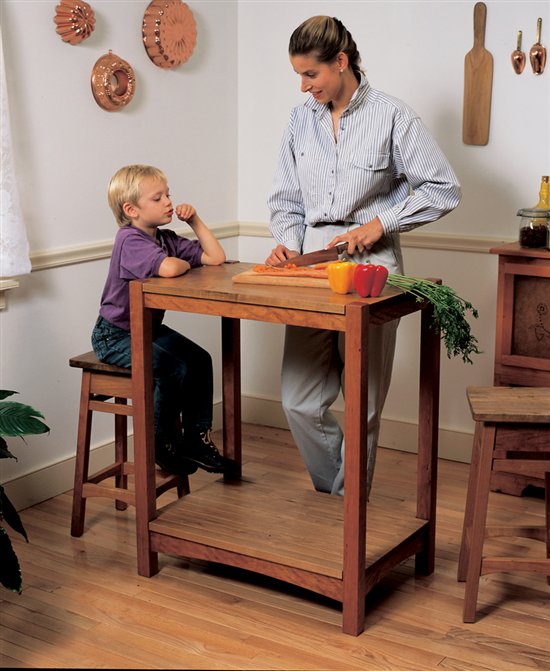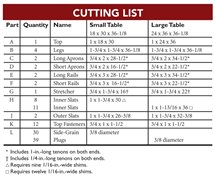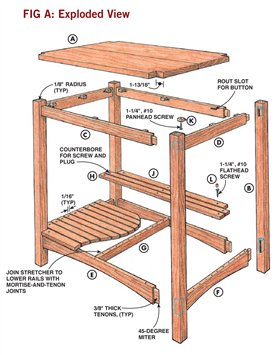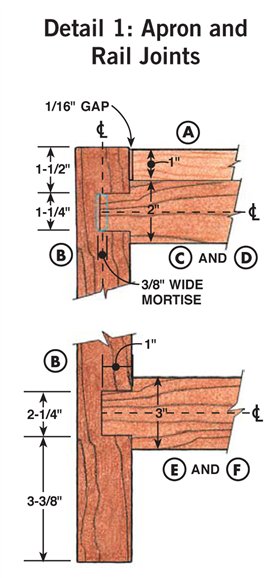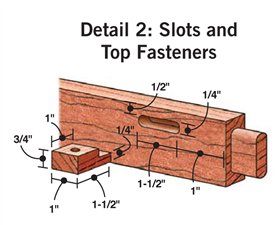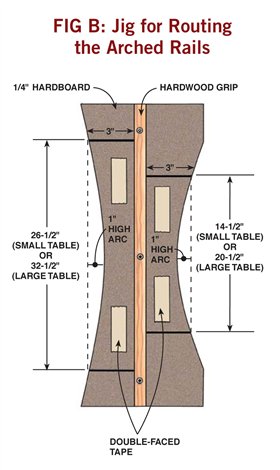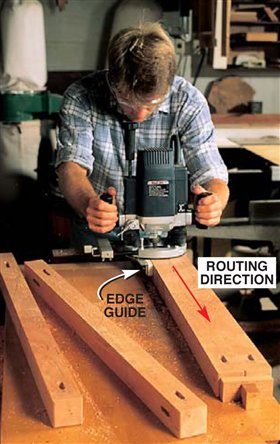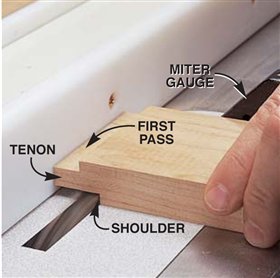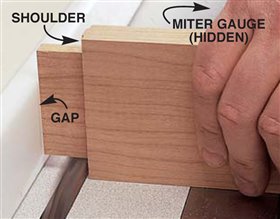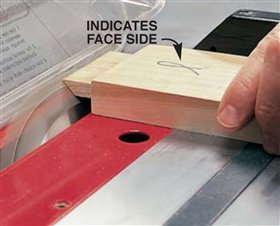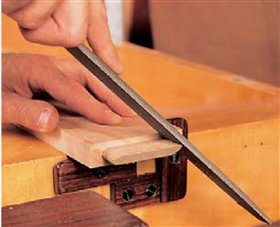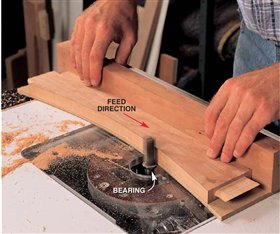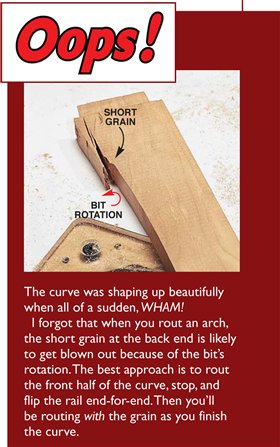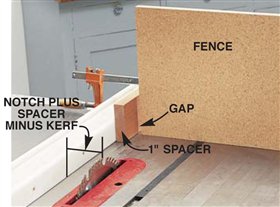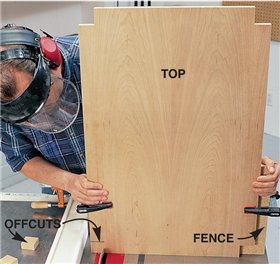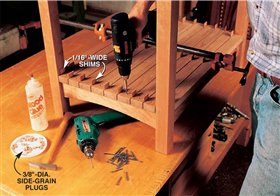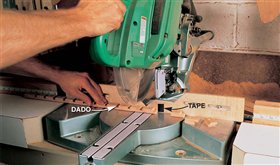|
Here’s a compact work table
that you could tuck away in a
corner or use as a central
island for daily activities. It’s the same
height as standard kitchen countertops,
so it’s perfect for food preparation and
other standing chores.
The Cutting List below has two
sets of dimensions; one for the 18-in.by
30-in. table shown here and another
for a larger 24-in.by 36-in. version.You
can easily build either table in a couple
of weekends. You’ll need a tablesaw, a
stacked dado set, a bandsaw or saber
saw, a drill press and a chop saw.You’ll
also need a plunge router to cut the
mortises and the curves on the rails.
Use your favorite hardwood, but
substitute hard maple for the top if you
plan to use it as a cutting surface. To
make the smaller version, you’ll need
about 12 bd. ft. of 5/4 stock for the top
and slats, four 3-1/2 ft. lengths of 2-in.
square stock for the legs and 5 bd. ft. of
4/4 stock for the aprons, rails and
stretcher. For the larger version, you’ll
need 20 bd. ft.of 5/4 and 7 bd. ft.of 4/4
stock. If you don’t have a jointer and
planer, have your lumber milled at the
lumberyard.
Mortise the Legs
When laying out the legs, orient the
end grain in a pleasing pattern because
it will be visible at the corners of the
finished top.Plunge-rout the mortises,
using an edge guide for your router
and a 3/8-in.-dia. up-cutting spiral bit
(Photo 1).
Once you’ve cut the mortises, switch
to a 1/4-in.-dia. straight bit and plungerout
the slots in the aprons for the top
fasteners, using the same gang-cutting
method (Fig.A,Detail 2).
Tenon the Aprons and Rails
Cut tenons on the tablesaw using a
carbide-tipped,stacked dado set (Photos
2 through 4). Any roughness on the
tenon cheeks left by the cutters can be
removed with a chisel or rabbet plane.
After the tenons are cut and mitered,
round their shoulders (Photo 5).
Rout Curves
The shallow curves on the lower rails
keep the table from looking bottomheavy.
Rout them with the help of a
double-sided, shop-made jig (Fig. B).
First, use the jig to transfer the curves
onto the rails. Saw the profiles, slightly
oversize, on a bandsaw or with a saber
saw.Then attach the rails to the jig and
rout the curves (Photo 6).
Notch the Top
The top is notched to fit inside the legs.
Leave a suitable gap (min. 1/16 in.)
around each leg so the top has room to
expand during humid conditions (Fig. A, Detail 1). With the proper setup, these
notches can be cut safely and precisely
on the tablesaw (Photos 7 and 8).
Attach the Slats
Mill all of the slats and drill
counterbored access holes for screws.
To space the slats evenly, lay them in
place on the lower rails with 1/16-in.-
thick shims in between (Photo 9). You
may have to joint a couple of slats or
add pieces of masking tape to some of
the shims to make everything fit.
With the shims in place, align the
ends of the slats and clamp them all
together. Drill pilot holes into the rails
and fasten the slats with screws. Fill the
screw holes by gluing in side-grain
wooden plugs (see Sources, below).
When the glue is dry, pare and scrape
the plugs flush with the slats.
Tip: Before you fasten the slats to the frame, finish their edges and bottoms. Once installed, these surfaces are difficult, if not impossible, to reach.
Fasten the Top
To center the top between the legs,use shims
of equal thickness all around.Secure the top
to the frame with wooden fasteners (Photo
10 and Fig. A, Detail 2).These fasteners allow
the top to expand and contract by sliding
inside the slots in the aprons.
Apply the Finish
Finish the top and frame separately so you
can seal every surface. A wipe-on varnish is
a good choice. Follow the instructions
on the can, and put on three or four
coats. After the first coat, it’s a good
idea to sand the surface with 220-grit
sandpaper.
If you prefer a food-safe finish on the
top, use Behlen’s Salad Bowl Finish or
Behlen's Preserve Oil (see
Source, below). Do not use vegetable
oil because it will turn rancid.
Source
(Note: Source information may have changed since the original publication date.)
Woodworker’s Supply, 800-645-9292,
Side-Grain Tapered Plugs, 3/8-in. dia., #800-031 Oak, #800-039 Maple, $14.59 for 100 plugs, #800-035 Walnut, $18.39 for 100 plugs;
Freud 50-110 Top-Bearing Flush-Trim Bit, #129-626, $46.99;
Behlen’s Salad Bowl Finish
#133-008, 1 qt., $22.59; Behlen's Preserve Oil,
#801-462, 8 oz. squeeze bottle, $13.49.
Cutting List

Fig. A: Exploded View

Detail 1: Apron and Rail Joints

Detail 2: Slots and Top Fasteners

Fig. B: Jig for Routing
the Arched Rails

This story originally appeared in American Woodworker June 2001, Issue #87.

|
|
Click on any image to view a larger version

1. Keep your router stable
while plunging the mortises by ganging
two legs together.Make several shallow
passes until you reach full depth.To
maximize the gluing surfaces, the
mortises meet inside the leg and the
tenons are mitered to fit (Fig.A).

2. Cut tenons on the aprons and
rails with a dado set and the miter gauge.
Make a first pass on both sides as shown,
then make the final pass using the rip fence
to establish the tenon length. Hold the
apron tight against the miter gauge and flat
on the table. Fine-tune the tenon thickness
by adjusting the blade height. Note: Using the rip fence and miter gauge simultaneously is safe only
when there will be no off-cut piece.The blade guard must be removed for
this cut. Be careful.

3. Cut shoulders on the ends of
the tenon after adjusting the height of
the blade. Hold the apron on its edge,
tight against the miter gauge and make
two passes, as in Photo 2. Keep the
tenon slightly away from the fence on
the final pass and pare away the
remaining waste with a chisel. Note: Using the rip fence and miter gauge simultaneously is safe only when there will be no off-cut piece.The blade guard must be removed for this cut. Be careful.

4. Miter the tenons, making sure
the angled edges are oriented properly
with the face side of the apron.

5. Round the shoulders of the
tenons with a rasp, making firm forward
strokes, so they’ll fit the mortises.

6. Rout the curved rails with a jig (Fig. B) and a flush-trim bit with a
top-mounted bearing (see Sources page 80). First rough-saw the curve on the
rail, leaving it about 1/8-in. oversize.Then mount the rail on the jig, using
double-faced tape.As you rout, the bit’s bearing rides on the jig’s curved edge.
Do half the curve, flip the rail over, and do the other half (see OOPS!, below). Note: The guard has been removed for photo clarity. Use yours!
Oops!


7. Before sawing the notches,
clamp a spacer block to the rip fence,well
in front of the blade. Screw a tall fence to
the miter gauge, leaving a gap so it won’t
bind against the spacer. Set the fence to the
combined widths of the notch and spacer,
minus the saw kerf. Raise the blade to the
height of the notch.

8. Cut notches after sliding the top
against the spacer block and clamping it firmly
to the tall fence.The spacer ensures an
adequate gap between the top and the rip fence
to keep the off-cut waste pieces from binding. Note: The blade guard must be removed for this cut. Be careful.

9. Attach the slats, using shims to keep them evenly spaced. Be sure to
put one shim between each leg and the adjacent slat. Use a clamp to keep the
slats aligned while the pilot holes are drilled and the screws are set.Wooden
plugs, glued in the screw holes and sanded smooth, create a finished look.

10. Cut wooden fasteners for the top from straight-grained stock
with evenly spaced dadoes sawn across its length. Black tape on the fence
indicates the correct length.
|



